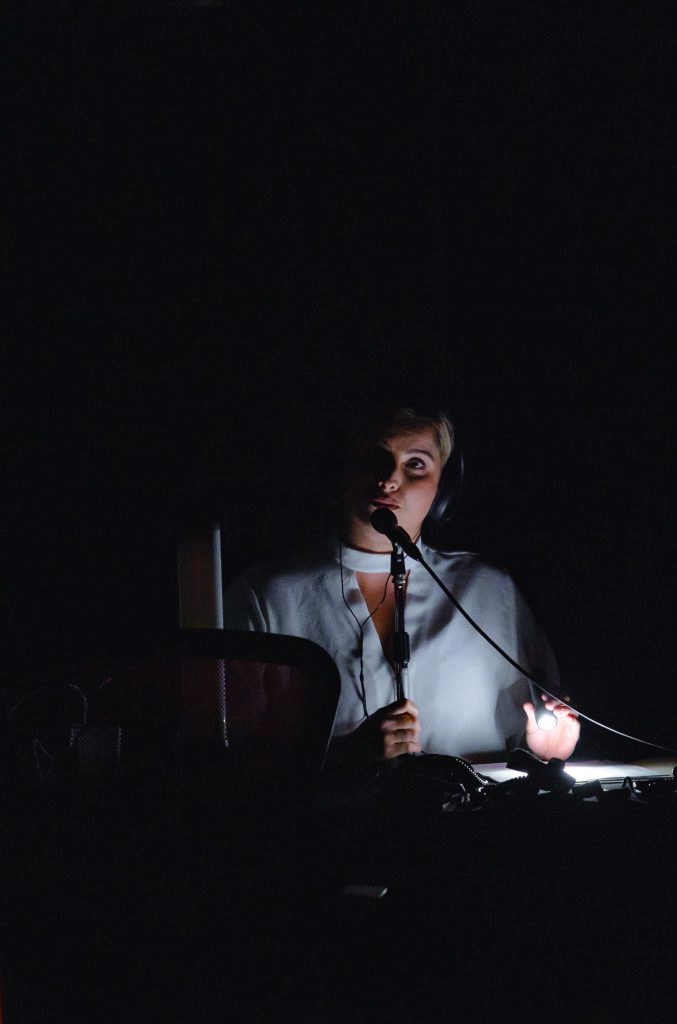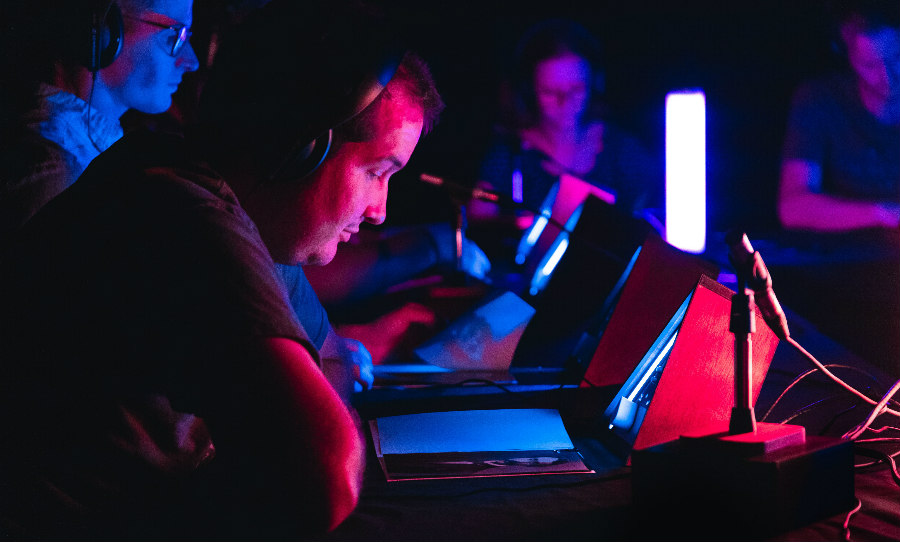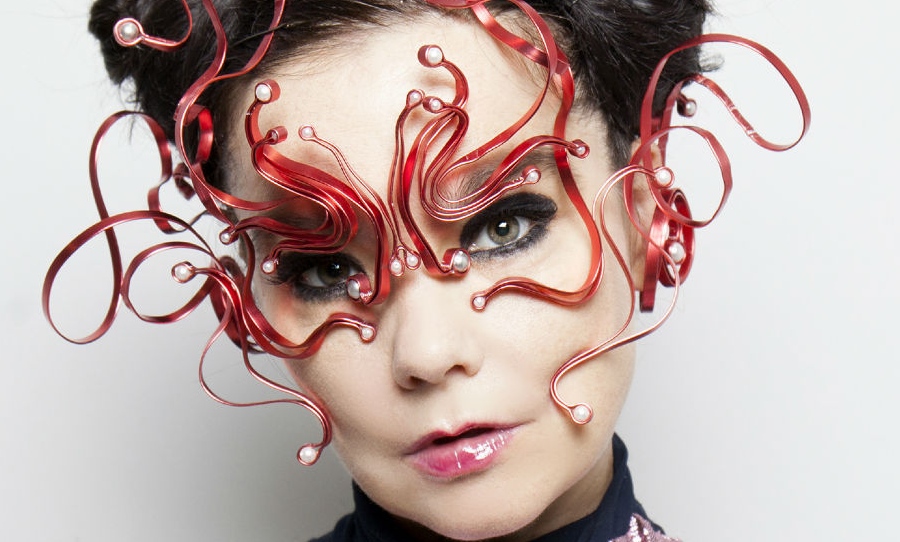TRUTHMACHINE is a multi-award-winning social experiment running at Brisbane Festival from the 10th-21st of September. Blurring the line between cutting-edge technology and live performance, TRUTHMACHINE uses biometric sensors, polygraphs and live voting systems to seek out the truth in a world of fake news and alternative facts.
Award-winning Brisbane-based theatre artist Nathan Sibthorpe is the brains behind the project, where a maximum of nine participants are invited into a small, dark interrogation room, lit up in neon-coloured light. Each participant then answers a series of questions fed to them via individual headphones, answering ‘true’ or ‘false’ by turning a dial on a triangular machine.
We caught up with Nathan Sibthorpe to find out more about the outcomes of this fascinating experiment and the inspiration behind it.

“There’s this feeling in the room that something quite confronting might be about to happen, but also that we’re all kind of up for it.”
HAPPY: What was the inspiration behind TRUTHMACHINE? What drew you to polygraphs?
NATHAN: After the notorious 2016 US election, the idea of ‘subjective truth’ has been in our faces. Oxford Dictionary’s word of the year for 2016 was ‘Post-Truth’ and everyone became very quickly familiar with the notions of “fake news” and “alternative facts.” There’s a lot of resistance to fact at the moment – this sense that nothing is sacred and everyone is free to rewrite the nature of the world around them on a whim.
We became interested in these ideas, and that led us to discover the history of the polygraph machine, which felt like an exciting allegory. Lie Detectors used to be considered scientific and factual – they were a hard and fast way to determine certainty. But for many years now, polygraph technology has been disputed. Now it’s broadly accepted that their methodology is inherently flawed. The truth can’t be found in your heart rate or breathing pattern any more than it can be found in the media or in the mouths of our political leaders.
So, this show challenges us to navigate the slipperiness of truth by taking a formal polygraph test with the intention to lie. We’re not making any clear sole statement about truth or lies, but instead we’re asking our audience to consider these questions from inside a strangely personal experience.
HAPPY: Did you have a desired outcome when creating this show?
NATHAN: It’s hard to be specific about what happens in the wake of this performance – but certainly we hope it leaves audiences feeling exhilarated and perhaps a little bit challenged. It’s definitely a unique thing to do for a night out, so we hope it leaves an impression. We should have a fun time, but leave with maybe more questions than answers.

HAPPY: Could you tell me about the technology that’s used in the show?
NATHAN: We built our own polygraph using biometric sensors – a heart rate monitor, a GSR sensor and a respiration strap. All of our work is built with tech-driven interfaces. We have a unique lighting design that is built into a set of custom interactive consoles. The light and sound respond to the biometric data from the polygraph to make everything feel alive. The design makes use of 3D printing and digital fabrication. The sound design is also a bit tricksy in its use of headphones and microphones. It’s not that the tech is necessarily new, but we take a unique approach in how we re-purpose tools and technologies for our own means.
HAPPY: What made you want to intertwine theatre and social experiment?
NATHAN: These are funny terms really, because to me all theatre is social, and the theatre we make is absolutely experimental! I suppose good theatre should change you in some way or show you something new, like how experiments are always scratching around for fresh understandings of the world.
HAPPY: Many of your shows in the past have been largely interactive experiences, and this one is no different. How does the interaction of different people affect the outcome of each performance?
NATHAN: The work constantly surprises us, but that’s because people are inherently surprising and sometimes it just takes the right provocations to bring that out. The participants are our performers, so the outcome absolutely depends on how people respond in the moment. This is risky of course, but I’m really drawn to work that opens itself up to this kind of chaos because this is really the lifeblood of what makes theatre theatrical!
HAPPY: What is the energy like during a TRUTHMACHINE show?
NATHAN: I really love the sense of danger. There’s this feeling in the room that something quite confronting might be about to happen, but also that we’re all kind of up for it. Something potentially hectic is about to happen – but it’s more like a roller coaster than a scary dentist appointment.
But of course the tension does break – and there are often moments that feel very cheeky, and strangely special. There’s a magical sense of vulnerability that brings people together in this encounter.

HAPPY: What was your intention behind keeping the show to only 20 minutes?
NATHAN: Well a short show’s a good show, right? We wanted to make a work that would suit the festival experience – it fits into a bigger night out so that you might be seeing other shows or engaging with other spaces before or after (I love me a big artsy night out at a festival!). But also the intimacy of the work is really important to us – so by keeping the runtime to 20min, we can host more shows in a night and keep the room limited to 12 people at a time. You wouldn’t want to do this show with a seating bank.
HAPPY: Have you drawn any inspiration from the TRUTHMACHINE shows that you’ve run so far for potential new shows in the future?
NATHAN: Absolutely! We learn something new about our practice with every project we do, and I think we’ve got a lot of floating interests for what might come next. Certainly the interactive game structure reveals something quite dynamic that we’re excited about. Last year we did CRUNCH TIME, which was similarly set around a hi-tech interactive table. I’m sure there’s still more for us to discover in this format.
Find out more about TRUTHMACHINE here.



